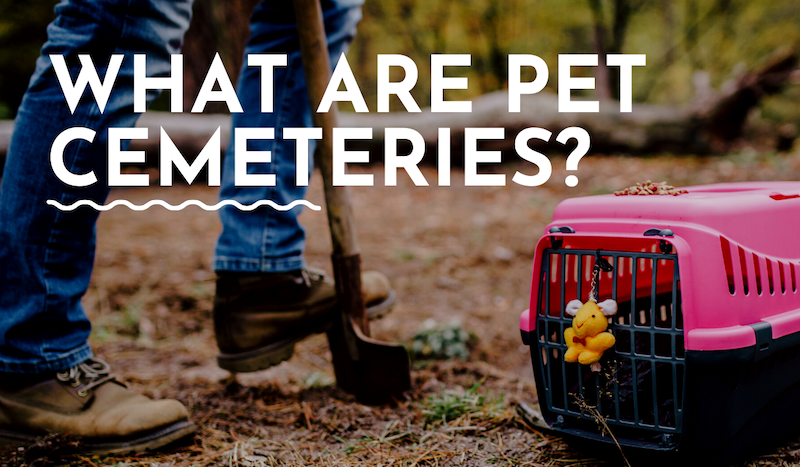A pet cemetery is a final resting place for pets, where they can be buried or cremated, and their remains can be memorialized.
These cemeteries have been an integral part of human culture for centuries, with evidence of animal burials dating back to ancient times. Today, they remain a popular choice for pet owners wishing to honor their cherished companions.
There are approximately 700 pet cemeteries in the United States alone and at least 400 more worldwide. These cemeteries accommodate a diverse range of pets, including dogs, cats, birds, and even exotic animals.
They typically provide designated areas for individual or communal burials, along with services such as pet funeral ceremonies, memorial markers, and grief counseling.
The costs associated with using a pet cemetery can vary based on location, chosen services, and the type of burial, but the emotional significance they offer is invaluable for many grieving pet owners.

What Are Pet Cemeteries?
Pet cemeteries are designated plots of land that provide a final resting place for your beloved companion, where you can visit and remember them.
In this section, we’ll explore the history of pet cemeteries and the types of pet cemeteries you can find today.
The History of Pet Cemeteries
Pet cemeteries have existed for thousands of years, dating back to the Ancient Egyptians, who are believed to have mummified and buried cats, which they considered deities.
On the other hand, the largest known dog cemetery in the ancient world was discovered at the Ashkelon National Park in Ashkelon, Israel.
The first pet cemetery in the United States was established in 1896 in Hartsdale, New York, and it is still in operation today.
However, despite being a thing for many years, it can be said that pet cemeteries gained popularity in the 20th century as pets started being seen more like family members and companions rather than animals that serve a purpose, such as catching rats around the house or keeping the household safe and alerting owners to intruders.
This shift in perception led to a greater desire to honor and memorialize pets like human family members, reflecting their emotional significance in people’s lives.
Today, pet cemeteries can be found in many countries around the world, and their popularity continues to grow.
The Types of Pet Cemeteries
There are various pet cemeteries to choose from, depending on your preferences. Here are some of the most common types:
| Type of Pet Cemetery | Description |
|---|---|
| Private Pet Cemetery | A cemetery that is owned and operated by an individual or family. |
| Public Pet Cemetery | A cemetery that is open to the public and owned and operated by a company or organization. |
| Faith-Based Pet Cemetery | A cemetery that is associated with a particular religion or faith. |
| Natural Pet Cemetery | A cemetery that allows pets to be buried without embalming or caskets and promotes natural decomposition. |
| Pet Cremation Cemetery | A cemetery that offers pet cremation services and allows for the burial of cremated remains. |
Pet cemeteries typically offer various services, including grave markers, pet caskets, and burial plots.
Some pet cemeteries also offer pet funeral services, where you can say goodbye to your pet in a formal setting.
Why Do People Use Pet Cemeteries?
There are several reasons why people opt for pet cemeteries instead of other options.
Emotional Benefits
For many pet owners, their pets are like family members.
Losing a pet can be just as devastating as losing a human loved one.
Using a pet cemetery can provide a sense of closure and comfort during the grieving process.
It can also give pet owners a place to visit and remember their furry friend.
Practical Benefits
In addition to the emotional benefits, there are also practical reasons why people use pet cemeteries.
Some cities and towns have laws against burying pets in your backyard, or zoning restrictions may make it difficult to find a suitable location.
Pet cemeteries offer a legal and convenient option for pet owners who want to bury their pets.
Pet cemeteries also offer a range of services, such as cremation and memorialization, that can be tailored to fit the needs of individual pet owners.
For example, some pet cemeteries offer memorial plaques or headstones, while others may offer urns for pet ashes.
In addition, pet cemeteries often have staff trained in handling pet remains and can provide guidance and support during the burial process.
This can be especially helpful for pet owners who are dealing with the loss of a pet for the first time.
What Happens at a Pet Cemetery?

Pet cemeteries offer various services and experiences for pet owners looking to honor their beloved companions.
Here’s a glimpse of what typically happens at a pet cemetery:
Burial Services
If you choose to bury your pet at the cemetery, you will be provided with a plot and a casket or container for your pet’s remains.
The cemetery staff will handle the burial process for you, including digging the grave and placing your pet’s casket or container in the ground.
You can choose to attend the burial service and say goodbye to your pet in person.
Cremation Services
Pet cemeteries also offer cremation services for those who prefer to keep their pet’s ashes.
You can choose to have your pet cremated and have their ashes returned to you, or you can choose to have their ashes scattered in a designated area of the cemetery.
Some pet cemeteries also offer communal cremation services, in which multiple pets are cremated together, and their ashes are scattered in a communal area.
Memorial Services
Pet cemeteries often provide memorial services to help you remember and honor your pet.
These services can include personalized memorials, such as engraved plaques or markers, as well as group memorial services where pet owners can come together to remember their pets.
Some pet cemeteries also offer grief counseling services to help pet owners cope with losing their beloved pets.
Choosing a Pet Cemetery

When choosing a pet cemetery, location, cost, and services offered are some of the essential factors to consider.
Location
When choosing the location for your pet’s final resting place, you want to opt for a tranquil space that’s easily accessible to you, especially if you plan to visit your pet’s grave regularly.
If you live in a metropolitan area where space is at a premium, space at the cemetery may be as well.
Therefore, it’s important to research the pet cemeteries in your area to find one conveniently located.
Cost
The cost of a pet cemetery plot can vary greatly depending on the cemetery and the size of the animal.
Therefore, while the average cost for smaller pets typically ranges from $300 to $500 or more, for large animals like horses, a plot may cost $1,000 or more.
Additionally, there may be extra expenses for services such as pet cremation, grave markers, and other burial-related costs.
Therefore, it is crucial to inquire about all associated costs before making a final decision to ensure a comprehensive understanding of the financial commitment involved.
Services Offered
Finally, when choosing a pet cemetery, it’s important to carefully consider the range of services offered to ensure they align with your needs and preferences.
Many pet cemeteries offer beyond basic burial services, such as pet cremation, which can be a preferred option for those wishing to keep their pet’s ashes in an urn or scatter them in a place of significance as well as personalized grave markers that allow pet owners to create a unique and lasting tribute with engravings, photos, or personal messages that capture the essence of their beloved companion.
Memorial services are often available, providing a structured way to commemorate the pet’s life with family and friends through ceremonies that might include readings, music, and shared memories.
Some cemeteries go a step further by offering grief counseling, which can be invaluable in helping owners process their loss.
Pet Cemetery Regulations
Regulations are meant to ensure pet owners have a safe and respectful place to bury their beloved pets without potentially risking someone else’s health and wellbeing.
Here are the two main types of regulations that govern pet cemeteries:
State Regulations
Each state has its own set of regulations that govern the operation of pet cemeteries.
These regulations cover a wide range of topics, including the types of animals that can be buried in pet cemeteries, the methods of burial that are allowed, and the types of markers that can be used to mark pet graves.
For example, in New York State, pet cemeteries are defined as:
“any land, place, structure, facility or building provided by any person for a fee, whether or not for profit, to veterinarians or members of the general public for use, or reservation for use, for the permanent interment or inurnment above or below ground of pet remains.”
Local Regulations
In addition to state regulations, pet cemeteries may also be subject to local laws.
These regulations are implemented by local governments, such as cities or counties, and may cover issues such as zoning, land use, and environmental concerns.
For example, a local government may require that pet cemeteries be located in certain areas, away from residential neighborhoods or sensitive environmental areas.
They may also require that pet cemeteries meet certain environmental standards, such as using biodegradable caskets or burial containers.
Overall, the regulations governing pet cemeteries ensure that pet owners have a safe and respectful place to bury their beloved pets.
If you are considering burying your pet in a pet cemetery, be sure to check with your local and state regulations to ensure that you are following all of the necessary rules and regulations.